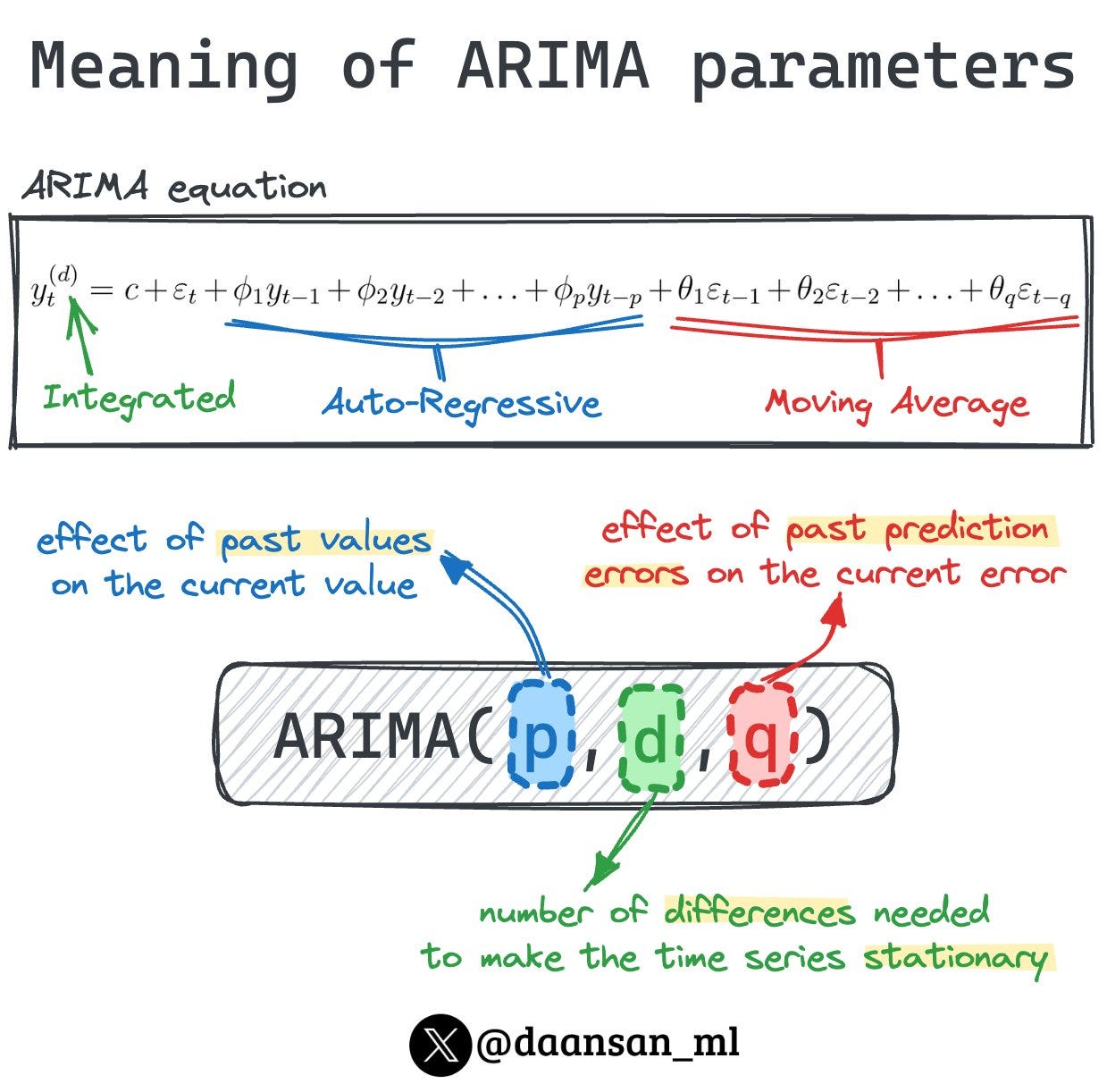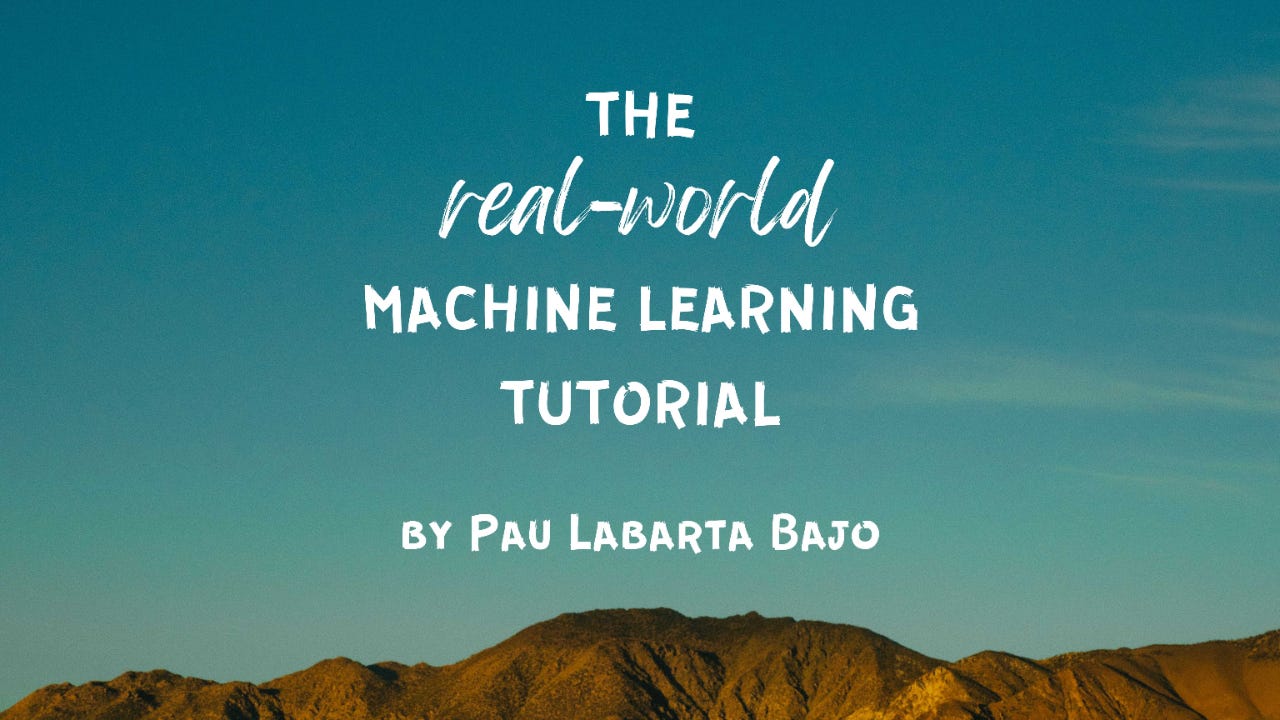This week:
Enjoy!
💊 Pill of the week
This week, let’s talk about ARIMA, a popular method for analysing and forecasting Time Series data. ARIMA, an acronym for Auto-Regressive Integrated Moving Average, stands out as a cornerstone in traditional statistical methods for time series forecasting. This approach comprises three components:
ARIMA Components
Auto-Regressive (AR)
The Auto-Regressive component of ARIMA models incorporates a linear combination of previous values of the variable of interest. This feature allows for capturing the serial correlation present in the time series data. By considering the influence of past observations on the current value, AR models provide valuable insights into the temporal dynamics of the series.Moving Average (MA)
In ARIMA, the Moving Average component plays a crucial role in modeling the short-term fluctuations or irregularities in the time series data. Unlike the Auto-Regressive component, which focuses on the influence of past values, the Moving Average component focuses on modeling the dependency between successive error terms. By incorporating a linear combination of past error terms, MA models effectively capture the short-term changes or shocks present in the data.Integrated (I)
The Integrated component of ARIMA is responsible for addressing the issue of non-stationarity in the time series data. By applying differencing techniques, the Integrated component transforms the original non-stationary series into a stationary one, making it possible to model the series using AR and MA components. The number of differencing operations performed is denoted by the parameter "d," which indicates the degree of differencing required to achieve stationarity.
You can find a summary on my post on X:
ARIMA Parameters
Following you can find the equation of an ARIMA model. Its length will depend on the order of the different terms (AR and MA). These are defined through two parameters: 'p' and 'q'. In addition, a third parameter 'd' is also defined to transform data into stationary and be able to model it with the previous two components.
Therefore, ARIMA models leverage three parameters: 'p', 'q', and 'd'. Understanding the meaning of these parameters is fundamental for fine-tuning the model's predictive prowess:
Order of Differencing (d)
Differencing serves as a pivotal technique to transform non-stationary time series data into a stationary format, essential for accurate modeling. The 'd' parameter signifies the number of differencing steps required to mitigate trends and seasonality present in the data, facilitating a more robust analysis.Order of Auto-Regressive Term (p)
The 'p' parameter reveals the significance of past observations in forecasting future values. When 'p' equals 1, it indicates a regression of the time series against its immediate preceding value. Higher values of 'p' extend this analysis to encompass multiple preceding observations, providing a comprehensive understanding of the temporal dynamics at play.Order of the Moving Average Term (q)
Conversely, the 'q' parameter captures the influence of past prediction errors on future forecasts. By regressing the prediction error against its preceding values, the 'q' parameter quantifies the impact of historical inaccuracies on the current forecast. Higher values of 'q' reflect a more pronounced consideration of past errors in shaping future predictions.
Let's recap that information:
'p' captures the impact of past observations on the current forecast, offering insights into the temporal dependencies within the data.
'q' captures the influence of past prediction errors on future forecasts, aiding in the refinement of predictive accuracy.
'd' characterises the differencing process, essential for achieving stationarity and enhancing the model's predictive capabilities.
You can also find this information in one of my posts on X:
Next week I’ll explain how you can select these parameters to optimise your model.
🎓Learn Real-World Machine Learning!*
Do you want to learn Real-World Machine Learning?
Data Science doesn’t finish with the model training… There is much more!
Here you will learn how to deploy and maintain your models, so they can be used in a Real-World environment:
Elevate your ML skills with "Real-World ML Tutorial & Community"! 🚀
Business to ML: Turn real business challenges into ML solutions.
Data Mastery: Craft perfect ML-ready data with Python.
Train Like a Pro: Boost your models for peak performance.
Deploy with Confidence: Master MLOps for real-world impact.
🎁 Special Offer: Use "MASSIVE50" for 50% off.
*Sponsored
🤖 Tech Round-Up
No time to check the news this week?
This week's TechRoundUp comes full of AI news. From Google’s brand new model to AI giants pact, the future is zooming towards us! 🚀
Let's dive into the latest Tech highlights you probably shouldn’t this week 💥
Google's Gemini Ultra is setting new standards for LLMs, offering deep integration across Google Workspace and a special Android app.
It's about making complex tasks simpler and more intuitive for everyone 🤖
Sora creates stunning 1080p videos from text, pushing boundaries with vivid characters and dynamic scenes 🎥
However, it still remains a research preview, focusing on safe AI development and real-world impact.
NVIDIA's latest tool empowers PC users to run GenAI models efficiently ⚙️
This opens up new possibilities for developers and researchers to innovate with AI technologies directly from their desktops.
4️⃣ 𝗦𝗹𝗮𝗰𝗸 𝗴𝗲𝘁𝘀 𝗶𝗻𝘁𝗼 𝘁𝗵𝗲 𝗔𝗜 𝗳𝗶𝗲𝗹𝗱
Slack is enhancing UX with AI-powered features.
It aims to improve it with search and summarization features, streamlining communication and information retrieval in the workplace 💬
5️⃣ 𝗔𝗜 𝗴𝗶𝗮𝗻𝘁𝘀 𝗽𝗮𝗰𝘁
AI giants have come together to establish a pact on political ad transparency.
This could set a precedent for responsible AI use in political campaigning 🤝
Keep reading with a 7-day free trial
Subscribe to Machine Learning Pills to keep reading this post and get 7 days of free access to the full post archives.









